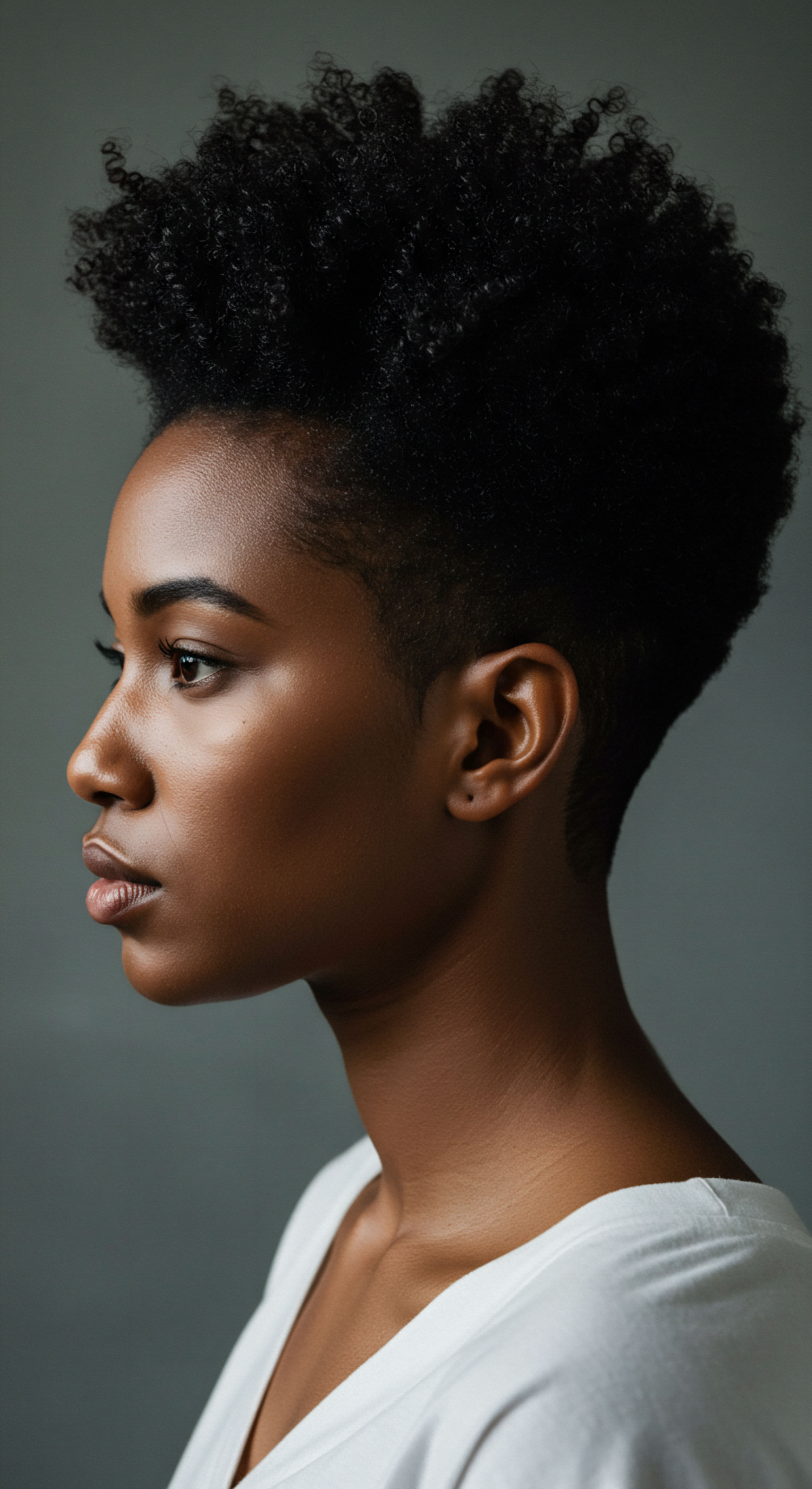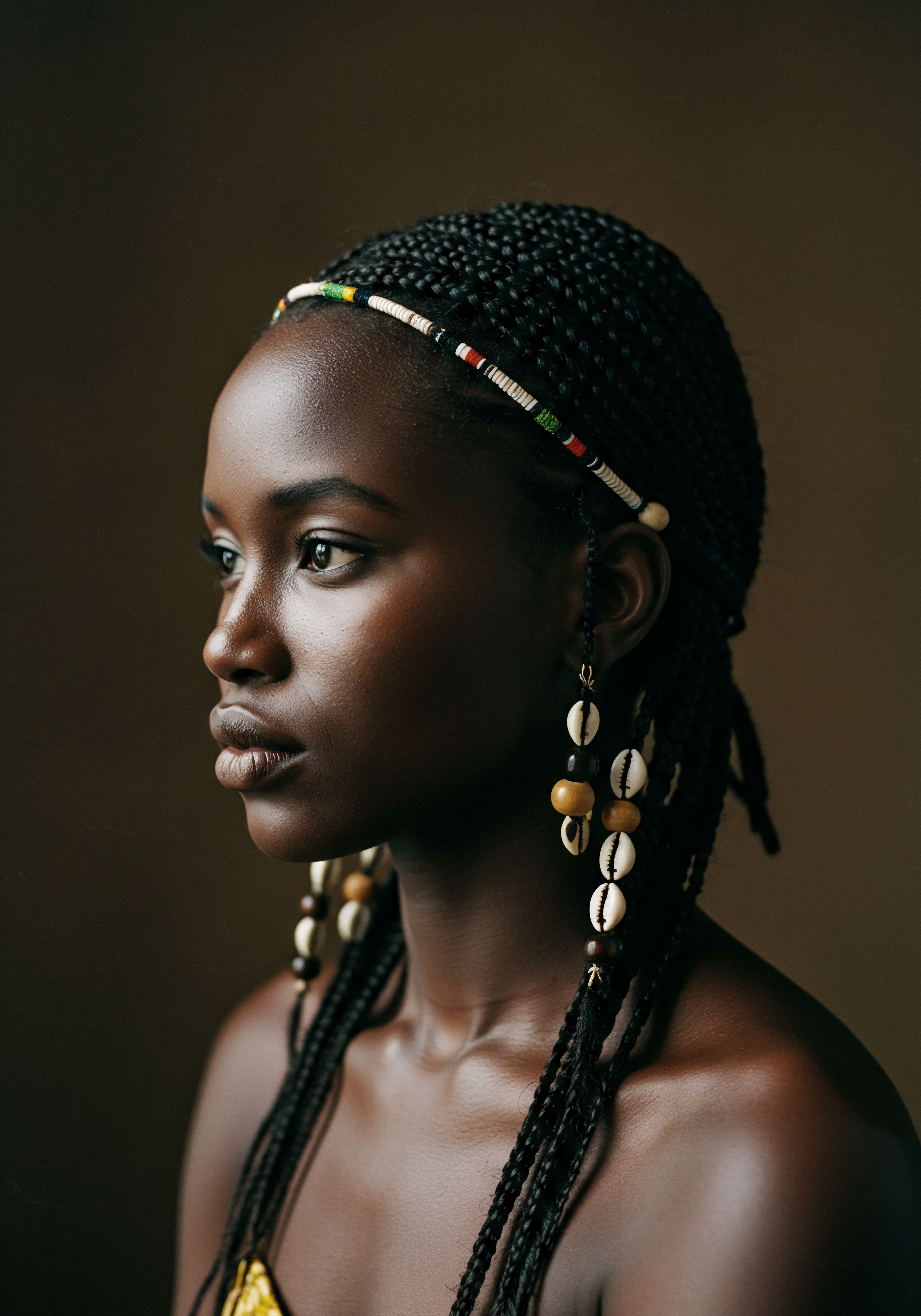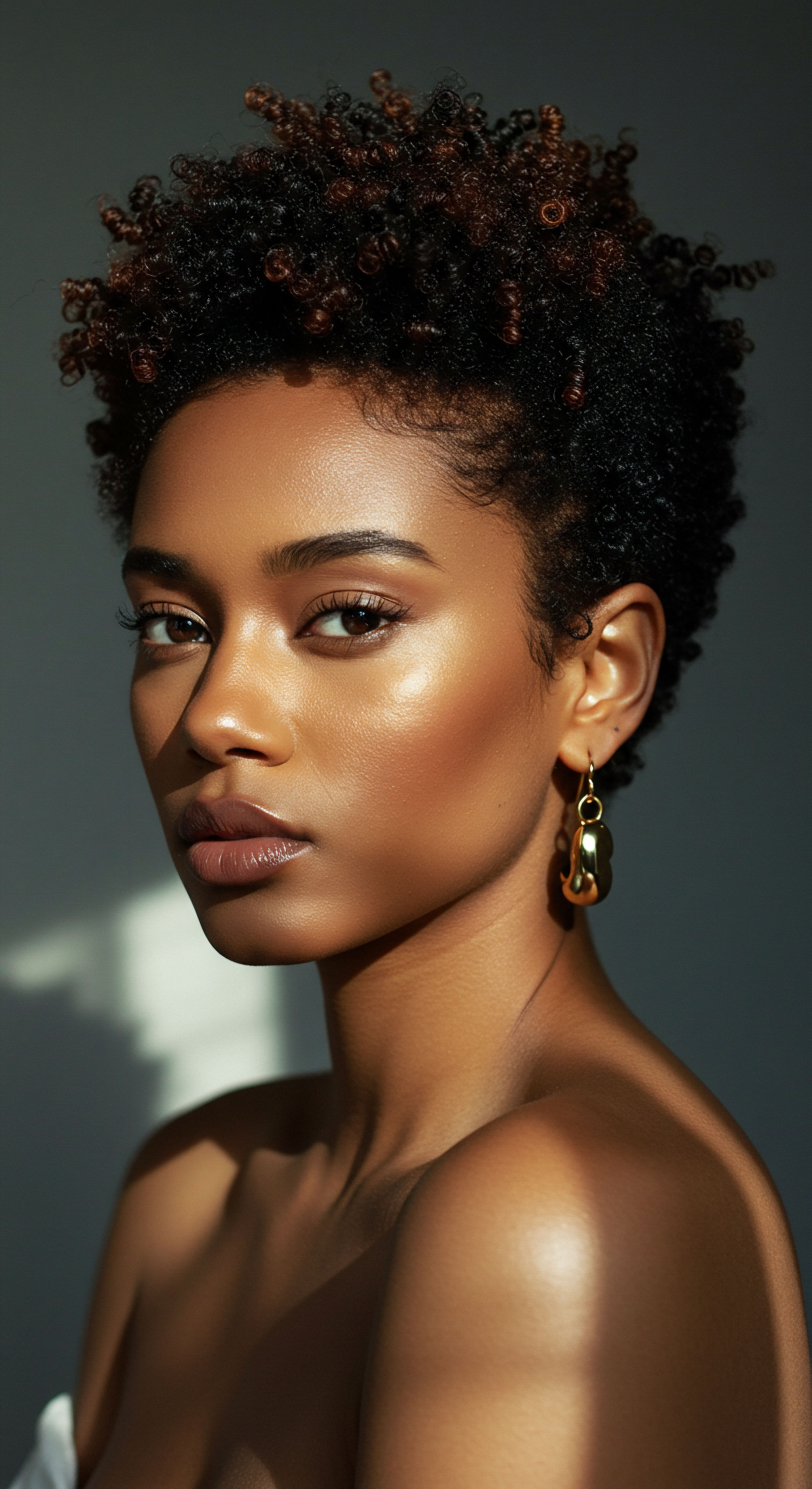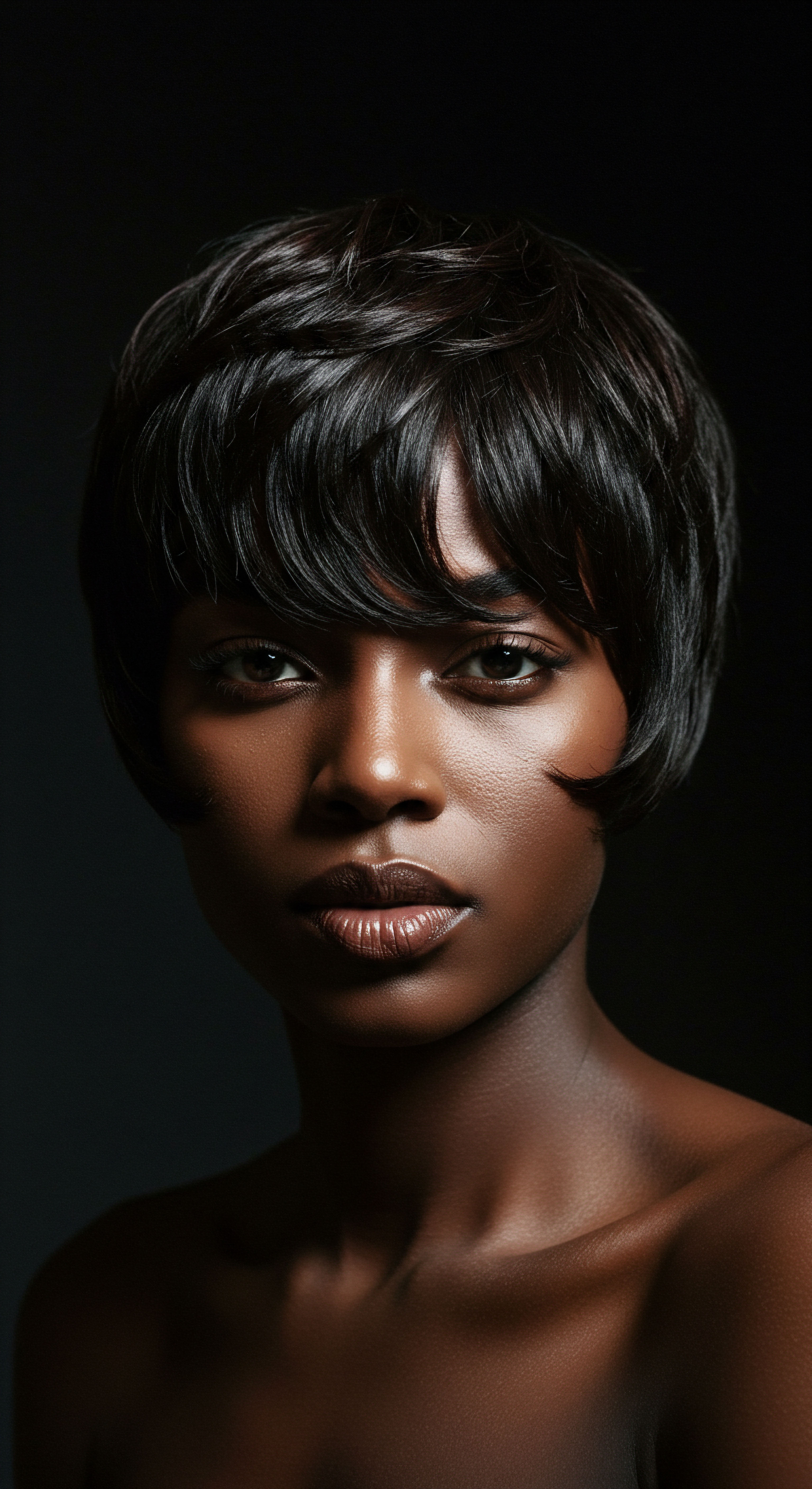
Roots
Step into an ancient realm, where the dry desert winds whispered secrets through the ages, and the sun held sway over every aspect of life. In this land, the adornment of the head transcended mere aesthetics, embodying deep cultural currents and practical necessities. To truly comprehend the grandeur and everyday utility of ancient Egyptian wigs, one must first consider their fundamental components, the very elements from which these symbols of status and hygiene were meticulously fashioned. These were not simple coverings; they were carefully constructed pieces, often reflecting an individual’s standing within a stratified society.
The most prized material for these elaborate headpieces was undoubtedly Human Hair. Its presence in well-preserved examples from archaeological sites underscores its value and widespread application. This precious commodity, frequently obtained through trade or even from the wearers themselves, was cleaned and prepared with utmost care, often separated into hundreds of individual lengths. The sheer volume of human hair required for a single wig, such as the British Museum’s Eighteenth Dynasty example, which comprises approximately 300 strands, each containing around 400 individual hairs, speaks to the dedication and resources invested in their creation.
Beyond human hair, the ancient Egyptian wigmakers skillfully incorporated a variety of other organic materials, demonstrating an ingenious adaptability to available resources. Plant Fibers represented a more accessible alternative, making wigs attainable for a broader segment of the population, even if their social standing might not permit the extravagance of human hair. Flax, linen, and the midrib fiber of the date palm were among these botanical choices, providing bulk and structure to the headpieces. The varying textures and properties of these plant materials allowed for different styles and forms, contributing to the diverse visual landscape of ancient Egyptian coiffure.
Animal Fibers also played a role in the composition of these ancient head coverings. Sheep’s wool, particularly black sheep wool, found its way into some of the more luxurious creations, sometimes even combined with human hair for a richer appearance. There is also evidence suggesting the occasional use of horsehair, though this appears to have been less common than human hair or plant fibers. The selection of these materials often hinged on the wearer’s economic standing and the desired aesthetic, with the finest and most expensive wigs often being those composed primarily of human hair.
Ancient Egyptian wigs were meticulously crafted from diverse organic materials, primarily human hair, supplemented by plant and animal fibers, each choice reflecting social standing and aesthetic preference.
The foundational structure of these ancient wigs was equally significant. Often, a mesh cap served as the base, providing a sturdy framework to which individual hair strands or fiber bundles could be attached. This mesh itself could be made from finely plaited human hair, creating a net-like surface with small, rhomboidal openings. This intricate base was essential for distributing the weight of the wig and ensuring its stability upon the head, a testament to the advanced wig-making skills of the period.

What Constitutes a Wig’s Core?
At the core of an ancient Egyptian wig, beyond the primary hair or fiber, lay the essential binders that held the elaborate styles in place. These were not mere styling products in the modern sense; they were structural components that ensured the longevity and integrity of the wig’s form, even in the hot, arid climate of Egypt. The most commonly identified binders include beeswax and conifer resin.
These natural substances, when warmed, would become pliable, allowing wigmakers to coat individual strands or sections of hair before affixing them to the mesh foundation. Upon cooling, this mixture would harden, setting the curls and plaits with remarkable durability.
Other substances, such as animal fat and various plant oils or gums, were also identified in some archaeological samples, suggesting a broader palette of binding agents or perhaps conditioning treatments. For instance, analysis of hair from certain mummies revealed a fat-like substance containing long-chain fatty acids, possibly a hair gel used for styling during life. The precise combination of these binders would have influenced the wig’s texture, sheen, and overall resilience.
| Material Type Human Hair |
| Characteristics Most authentic appearance, often intricately styled. |
| Typical Social Affiliation Elite, Royal, Upper Class |
| Material Type Sheep's Wool |
| Characteristics Provided volume, sometimes blended with human hair. |
| Typical Social Affiliation Elite, Middle Class (blended) |
| Material Type Flax/Linen Fibers |
| Characteristics Affordable, used for bulk and simpler constructions. |
| Typical Social Affiliation Middle Class, Lower Class |
| Material Type Date Palm Midrib Fiber |
| Characteristics Sturdy, provided structural support, specific applications. |
| Typical Social Affiliation Varied, including specialized ceremonial wigs |
| Material Type Horsehair |
| Characteristics Less common, sometimes used for specific textures. |
| Typical Social Affiliation Less documented, likely niche applications |
| Material Type The choice of wig material reflected both availability and the wearer's position in ancient Egyptian society. |
The longevity of these ancient creations, with many surviving millennia, is a testament to the efficacy of these natural binders and the skilled hands that applied them. They allowed the wigs to maintain their elaborate shapes, from tight curls to cascading plaits, even under the harsh desert sun. The understanding of these fundamental materials provides a foundational perspective on the artistry and ingenuity that characterized ancient Egyptian wig-making.

Ritual
To truly appreciate the elaborate wigs of ancient Egypt, one must consider the practical artistry involved in their making, a process that transcended simple fabrication to become a thoughtful practice. These were not mass-produced articles but rather bespoke creations, each strand and curl a testament to the skill of ancient wigmakers. The daily or ceremonial practices surrounding these hairpieces extended beyond mere wearing, encompassing a detailed regimen of creation, care, and purposeful adornment. This section peels back the layers of time to reveal the techniques and intentions that shaped these significant objects.
The journey of an ancient Egyptian wig began with the careful preparation of its primary components. Human hair, once acquired, underwent a thorough cleaning process before being meticulously separated into uniform lengths. For a substantial wig, this could involve preparing hundreds of individual bundles, each containing numerous hair strands. This initial phase established the raw material, setting the stage for the intricate construction to follow.
The creation of the wig’s foundation was a painstaking endeavor. Wigmakers would typically construct a mesh cap, often from finely plaited human hair, forming a net-like structure. This base provided the necessary support and allowed for air circulation, a practical consideration in the hot climate.
On a wooden wig mount, similar to those used by modern wigmakers, individual lengths of prepared hair were then attached to this mesh. This attachment involved looping the root end of each hair length around the horizontal mesh, pressing it into a warmed setting mixture, and often securing it further with a sub-strand or knotting.

How Were Wigs Structured for Wear?
The method of attachment and styling relied heavily on the unique properties of the binding agents. A common mixture consisted of two-thirds beeswax and one-third conifer resin. This blend, warmed to a pliable consistency, served as a powerful adhesive, holding the hair firmly in place once it cooled and hardened.
The melting point of beeswax, between 140°F and 149°F (60°-65°C), meant these wigs could withstand the intense Egyptian heat without losing their form. This meticulous application of binders was crucial for maintaining the elaborate curls, waves, and plaits that characterized ancient Egyptian wig styles.
The styling itself was an art form. Wigmakers would curl hair artificially, perhaps using pin curl techniques, and create hundreds of thin plaits that would cascade around the neck or form layered, voluminous styles. The result was a sophisticated coiffure that could take up to 200 hours to complete for a single wig, especially if intricate plaits were styled directly on the wig mount.
Ancient Egyptian wig creation was a precise craft, involving meticulous hair preparation, the construction of intricate mesh foundations, and the artful application of natural binders like beeswax and resin to set elaborate styles.
Beyond their visual appeal, wigs served profound practical and ritualistic purposes. In a climate where hygiene was a constant concern, wigs offered a solution for cleanliness. Many Egyptians, especially priests, shaved or closely cropped their natural hair to prevent lice infestations.
The wig, being removable, could be cleaned or aired, maintaining a level of purity difficult to achieve with natural hair. This aspect was particularly significant for priests, who maintained shaved bodies to preserve ritual purity during their duties.
Furthermore, wigs provided protection from the scorching sun, acting as a shield for the shaven scalp. Their often voluminous nature offered a degree of shade, making daily life in the sun-drenched landscape more comfortable. Wigs also offered a means to cover thinning hair or baldness, a concern even in ancient times, with remedies and recipes for hair growth remedies being documented.
- Hair Preparation ❉ Cleaning and separating human hair into individual lengths, often hundreds of bundles for a single wig.
- Foundation Construction ❉ Creating a mesh cap, typically from finely plaited human hair, to serve as the wig’s supportive base.
- Binder Application ❉ Warming mixtures of beeswax and conifer resin to coat hair strands and secure them to the mesh foundation.
- Styling Techniques ❉ Artificially curling and plaiting hair into elaborate designs, which could take hundreds of hours to complete.
The deliberate choice of materials and the sophisticated construction methods reveal a society that understood the interplay between appearance, practicality, and symbolic meaning. The creation of these wigs was not merely about fashion; it was a deeply ingrained practice, reflecting an awareness of personal well-being and societal roles.

Relay
Moving beyond the foundational elements and crafting techniques, we approach a deeper exploration of ancient Egyptian wigs, inviting contemplation on their scientific composition and profound cultural resonance. What stories do these preserved artifacts whisper about the lives, beliefs, and societal structures of a civilization so distant, yet so connected to our own human experience of self-presentation? Unearthing the precise chemical makeup of these ancient hairpieces reveals not only the materials used but also the ingenuity and resourcefulness of their creators, painting a more complete picture of their world.
Modern scientific analysis has brought forth compelling insights into the composition of ancient Egyptian wigs, occasionally revealing details that challenge conventional assumptions. While human hair, beeswax, and conifer resin are frequently documented, specific studies sometimes illuminate less common or unexpected materials and binding agents. This rigorous examination provides a scientific lens through which to comprehend the complexities of ancient cosmetic practices.

What Unique Discoveries Uncover Ancient Wig Composition?
A notable example arises from the analysis of a wig found on the mummy of the “Screaming Woman,” an anonymous individual from the area beneath Senmut’s Theban tomb (TT71), dating to the Eighteenth Dynasty. Scientific investigations using techniques such as Fourier-Transform-Infrared-Spectroscopy (FTIR) and Scanning-Electron-Microscope (SEM) revealed that this particular wig was composed of Plant Fibers from the Date Palm Midrib. This discovery presents a compelling departure from the more commonly cited human hair or sheep’s wool. The fibers were partially coated with a thick substance, identified as crystalline, a material comparable to those found in an ancient wig-making workshop.
Further analysis of samples from the “Screaming Woman” mummy’s skin, natural hair, and wig revealed the application of various embalming materials. While juniper resin was identified as a primary component on skin and wig samples, frankincense was also found on both, and henna was detected on the natural hair. This scientific data suggests a sophisticated understanding of material properties and their application, perhaps serving both cosmetic and preservative functions. The presence of specific plant fibers and unique binders offers a window into regional variations, individual preferences, or specialized ceremonial uses that extend beyond the standard understanding of wig construction.
| Wig/Sample Origin British Museum Wig (EA2560) |
| Primary Hair/Fiber Human Hair |
| Identified Binders/Coatings Beeswax, Conifer Resin |
| Analytical Technique Microscopic, Chemical Analysis |
| Wig/Sample Origin Meryt's Wig (Turin Museo Egizio S. 8499) |
| Primary Hair/Fiber Human Hair |
| Identified Binders/Coatings Plant Oil, Balsam (distinct from beeswax/resin) |
| Analytical Technique GC/MS Analysis |
| Wig/Sample Origin "Screaming Woman Mummy" Wig |
| Primary Hair/Fiber Date Palm Midrib Fiber |
| Identified Binders/Coatings Crystalline Substance, Juniper Resin, Frankincense |
| Analytical Technique FTIR, SEM, XRD Analysis |
| Wig/Sample Origin Various Mummies (Hair Samples) |
| Primary Hair/Fiber Natural Hair |
| Identified Binders/Coatings Fatty Acids (e.g. palmitic, stearic) – a 'hair gel' |
| Analytical Technique Gas Chromatography–Mass Spectrometry |
| Wig/Sample Origin Advanced scientific methods continue to reveal the complex and varied compositions of ancient Egyptian wigs and hair treatments. |
The role of wigs in ancient Egyptian society transcended mere fashion. They were powerful visual signals of identity, status, and even religious adherence. Both men and women of the elite classes wore elaborate wigs, signifying their wealth and position within the social hierarchy.
The more wigs an individual owned, and the grander their design, the higher their perceived status. Hair itself carried deep cultural meaning, embodying aspects of gender, age, and social standing.
Scientific analysis of ancient Egyptian wigs unveils surprising material diversity, with specific findings like date palm fibers and unique crystalline coatings expanding our understanding of ancient cosmetic artistry.
Beyond status, wigs served practical purposes that contributed to well-being. They protected the scalp from the intense Egyptian sun, especially for those who shaved their heads for hygiene or ritual purity. The ability to remove and clean wigs also aided in preventing infestations of lice, a significant concern in a densely populated society. Priests, in particular, maintained shaved heads to preserve their ritual purity, relying on wigs for protection and appearance.

How Did Wigs Shape Social Perceptions?
The economic implications of wig production were also substantial. Human hair, as a primary material, was a valuable commodity, sometimes listed alongside gold and incense in ancient accounts. The creation of a single, complex wig could be incredibly time-consuming, requiring up to 200 hours of skilled labor.
This extensive investment of time and resources meant that complete wigs were largely restricted to the elite, making them a clear marker of distinction. Even wigs made from less expensive plant fibers required sophisticated craftsmanship, contributing to their overall cost.
- Social Standing ❉ Wigs served as clear visual indicators of wealth and status, with more elaborate designs corresponding to higher societal positions.
- Hygiene and Protection ❉ Wigs offered a practical solution for cleanliness, preventing lice, and shielding shaved scalps from the sun.
- Ritual Purity ❉ For priests, shaved heads maintained ritual purity, with wigs providing an appropriate appearance for daily life and ceremonies.
- Aesthetic Expression ❉ Wigs allowed for diverse and elaborate hairstyles, reflecting changing fashion trends and personal aesthetic preferences.
- Symbolic Meanings ❉ Hair and wigs held symbolic meanings, sometimes associated with fertility goddesses like Hathor or even with expectations for rebirth in the afterlife.
The ongoing scientific investigation of these ancient artifacts continues to reveal layers of meaning, connecting material science with cultural practices. Each discovery refines our understanding of how ancient Egyptians interacted with their environment, expressed their identity, and prepared for both earthly existence and the journey beyond. The wigs, therefore, are not merely static museum pieces; they are dynamic conduits to a distant past, inviting continuous dialogue and deeper comprehension.

Reflection
As we draw back from the intricate world of ancient Egyptian wigs, a profound sense of continuity settles upon us. The desire to adorn, to protect, to express one’s inner self through the external presentation of hair, echoes across millennia. The meticulous selection of human hair, the ingenious use of plant fibers and animal wool, the careful blending of beeswax and resin—each choice speaks to a deep understanding of materials and a profound appreciation for personal appearance.
These ancient creations, with their layers of purpose and artistry, remind us that the story of hair is a timeless human story, ever evolving yet always rooted in fundamental needs for identity, well-being, and connection. The echoes of their practices continue to resonate, offering a quiet wisdom about the enduring human spirit and its quest for beauty and meaning.

References
- Cox, J. S. 1977. The construction of an ancient Egyptian wig (c.1400 BC) in the British Museum. Journal of Egyptian Archaeology 63 ❉ 67-70.
- Fletcher, Joann. 1995. Ancient Egyptian Hair ❉ A Study in Style, Form and Function. Unpublished PhD thesis, University of Manchester.
- Fletcher, Joann. 2000. Hair. In Ancient Egyptian Materials and Technology, edited by P. Nicholson and I. Shaw, 495-501. Cambridge ❉ Cambridge University Press.
- Fletcher, J. and F. Salamone. 2016. An Ancient Egyptian Wig ❉ Construction and Reconstruction. Internet Archaeology 42.
- Buckley, S. A. and R. P. Evershed. 2001. Organic chemistry of embalming agents in Pharaonic and Graeco-Roman mummies. Nature 413(6858) ❉ 837-841.
- McCreesh, D. T. and A. R. David. 2011. Ancient Egyptian hair gel ❉ New insight into ancient Egyptian mummification procedures through chemical analysis. Journal of Archaeological Science 38(12) ❉ 3432-3434.
- Watterson, Barbara. 2013. Women in Ancient Egypt. Amberley Publishing.
- Samson, Julia. 1973. Amarna ❉ City of Akhenaten and Nefertiti. Aris & Phillips.
- Strudwick, Nigel. 2006. Masterpieces of Ancient Egypt. London ❉ British Museum Press.
- Taylor, John H. and Daniel Antoine. 2014. Ancient Lives, New Discoveries. London ❉ British Museum Press.
- Zink, A. R. and A. Nerlich. 2011. The mummy of the ‘Screaming Woman’ from the area beneath Senmut’s Theban tomb (TT71) ❉ A case study of paleoradiological and scientific investigations. Paleoradiology ❉ Imaging the Past.